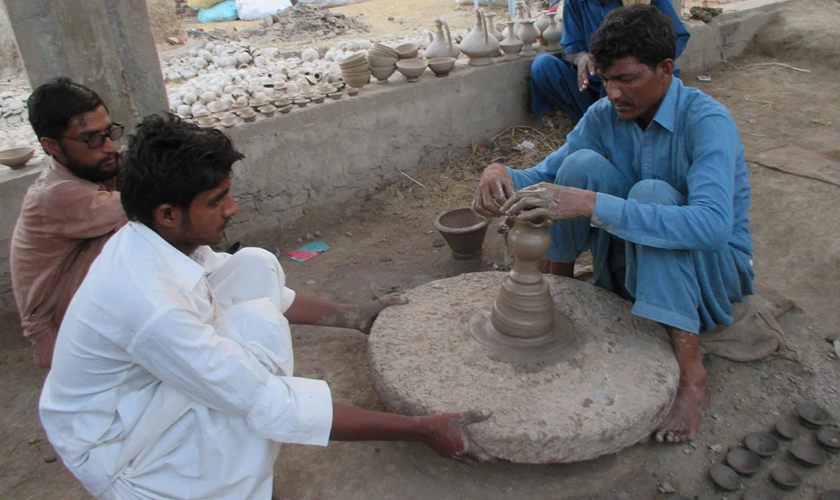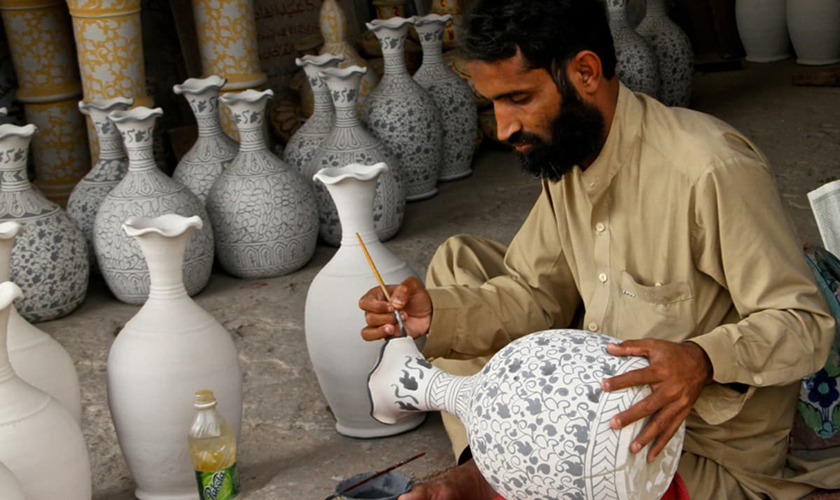HANDCRAFTS
 The people of the Kehal tribe have had a long time association with water, be it the river streams, the flowing old canals or the lakes, as these waters provide them with an essential raw material they need to hand weave their products.
The people of the Kehal tribe have had a long time association with water, be it the river streams, the flowing old canals or the lakes, as these waters provide them with an essential raw material they need to hand weave their products.
They collect vegetation, sticks and grasses, which are only found near these streams, backwaters, riverbeds, abandoned catchment areas, and canal banks, to make baskets.
Basket weaving is an important practice for these people. The artisan women’s routine includes getting up early in the morning and beginning to use these wet sticks to weave baskets. They have various sizes and designs in their mind, and they world the entire day in groups.
Mai Karima, sitting on the wet sand along the thin stream, recalls the blissful days long ago when the river used to flow with more water, bringing happiness for fishermen and other people depending on the river for livelihood.
The family of Mai Karima lives along the river stream near Hala Old Town, which was once rich in forest economy. There was a time when forest communities could bring in fully-packed boats with firewood, herbal plants, honey and many more items for sale.
At that time, Hala had major links with similar flourishing forest towns located on the other side of the river. The major source of transport in those days was a boat. The riverine communities had their role in the supply chain with valuable commodities.
The work is divided within family members: males bring raw sticks of a plant lai (Tamarix dioica), which they keep in the water for at least 48 hours and then women artisans use wet sticks to prepare different sizes of products as per demand in the market.
"We have to collect useful plants, which are available near there for manufacturing of baskets. Our men bring this raw material and we use the same here," Karima said, while giving the final touches to a medium-size basket.
There are heaps of raw sticks near the canal, with some submerged in the water for later use. Children swim in the water and play with the sand at the bank of the canal.
Relying on the naturally available material, and also due to close proximity, these artisans do not have to spend a single rupee to buy raw materials. All they need to make the products is collected from the river bed and backwaters located nearby.
Each woman artisan can build two-three baskets of different sizes in a day. Customers frequently visit them to buy the readymade item.
They do not have fixed prices for the products, but normally baskets are sold from Rs100 to Rs500, depending on the size and texture. The women earn enough to contribute to their families’ income.
The baskets are used for storing and keeping various fruits and vegetables. The small-sized baskets are used by gardeners to keep mangoes, phalsa (Grewia asiatica), jamun (Syzygium jambolanum), and other seasonal fruits and vegetables. It is used for protecting the products from rotting, as the basket allows airflow.
They have makeshift sheds along the river streams and at embankments where they work to avoid scorching heat. Otherwise, in normal weather, they prefer to work in the open.
Small fishing boats are fixed with ropes waiting for clients. Fishermen ply these boats for communities to cross the stream.
Nazik Kehal, Karima’s husband has this specific work. According to him, this river gives a lot to them annually. "We never get afraid of floods and increasing flow," he said.

Recalling the old days, he said their families have been familiar with riverine and forest communities, crocodiles, otters, and other wildlife species. "But we never bring any harm to these innocent animals," he said.
Their old practice of keeping to themselves and working on their specific tasks without harming the environment helps understand them as peace-loving people. They engage their growing children in the traditional work to train them too. Their children learn swimming at an early age and they are known divers.
Kehal people are eyewitness to the changes, destruction and displacement around them, that has taken place over years after years. They can count how the important and valuable vegetations, shrubs and grasses are disappearing fast from the environment, as they have to pay a heavier cost of this destruction.
Traditional anthropologists believe that climate change has impacted lifestyle and old cultures of nomadic people belonging to different tribes, who live in scattered groups in the province of Sindh. Many of them have adopted different skill works for their survival.
Despite having more knowledge about the river, freshwater fish, and forest economy the Kehal tribe people live anonymously. Mostly, they have this tradition where men do not move to the market for selling products. Instead, buyers themselves come frequently to buy the manufactured goods. Only their vocal women deal with clients to sell their products to earn a better living.
These tribe people always collect grains during the wheat harvest and reaping season.
Some researchers point out that the families of this tribe have been residing along the river Indus, flowing from Punjab to the tail end of Sindh province. They are adaptable in language and culture to live peacefully in all areas.
Whenever the river water recedes, some of their relatives move to canals and freshwater banks looking for raw material. They continue to engage in their craft of making different sizes of mats, baskets, ropes and toys, while others stay back near small streams.
Similarly, during floods they consider river embankments as better places where they live peacefully and continue to work. The product itself attracts the clients close to them.

The skills of these traditional artisans have been transferred from generation to generation. Though there have been many changes and variations in the traditional weaving techniques, no great advancements have been made by these craftspeople in adapting the designs to modernity and market demand.
Likewise, there is no government institution, which specifically extends help to these well-skilled people. There are no training institutes for them where they can go to learn modern techniques and marketing strategies to enhance their rural economy or get access to urban markets. Like many rural industries, this one too has its value and usefulness, which needs to be promoted to save the livelihoods of hundreds of people associated with this work.
The writer is a staff membe